 W
WThe bhāvacakra is a symbolic representation of saṃsāra. It is found on the outside walls of Tibetan Buddhist temples and monasteries in the Indo-Tibetan region, to help ordinary people understand Buddhist teachings. It is used in Indian Buddhism & Tibetan Buddhism
 W
WBuddhist symbolism is the method of Buddhist art to represent certain aspects of dharma, which began in the fourth century BCE. Anthropomorphic symbolism appeared from around the first century CE with the arts of Mathura the Greco-Buddhist art of Gandhara, and were combined with the previous symbols.
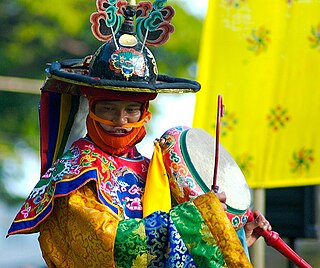 W
WThe cham dance is a lively masked and costumed dance associated with some sects of Tibetan Buddhism and Buddhist festivals. The dance is accompanied by music played by monks using traditional Tibetan musical instruments. The dances often offer moral instruction relating to karuṇā (compassion) for sentient beings and are held to bring merit to all who perceive them.
 W
WThe Cup is a 1999 Tibetan-language film directed by Khyentse Norbu. The plot involves two young football-crazed Tibetan refugee novice monks in a remote Himalayan monastery in India who desperately try to obtain a television for the monastery to watch the 1998 World Cup final.
 W
WDzi bead is a type of stone bead of uncertain origin worn as part of a necklace and sometimes as a bracelet. In several Central Asian cultures, including that of Tibet, the bead is considered to provide positive spiritual benefit. These beads are generally prized as protective amulets and are sometimes ground into a powder to be used in traditional Tibetan medicine. Beads subject to this process have small "dig marks" where a portion of the bead has been scraped or ground away to be included in the medicine. Some dzi exhibit grinding and polishing of one or both ends, again the result of reduction for use in traditional Tibetan medicine or, in some cases, due to the bead's use as a burnishing tool in the application of gold leaf to thanka paintings or gilt bronze statuary.
 W
WA khata or khatag(Tibetan: ཁ་བཏགས་ ; Dzongkha: དར་, dhar, Mongolian : ᠬᠠᠳᠠᠭ / Mongolian: хадаг / IPA: [χɑtɑk], khadag or hatag, Nepali: खतक khada, Chinese 哈達/哈达; pinyin: hādá/hǎdá) is a traditional ceremonial scarf in tengrism and Tibetan Buddhism. It originated in Tibetan culture and is common in cultures and countries where Tibetan Buddhism is practiced or has strong influence.
 W
WLhabab Düchen is one of the four Buddhist festivals commemorating four events in the life of the Buddha, according to Tibetan traditions. Lhabab Düchen occurs on the 22nd day of the ninth lunar month according to Tibetan calendar and widely celebrated in Tibet and Bhutan. The festival is also celebrated in other Buddhist Asian countries including Sri Lanka, Myanmar, Thailand and Laos where it is celebrated a few weeks before the Tibetan and Bhutanese version.
 W
WLittle Buddha is a 1993 drama film directed by Bernardo Bertolucci, written by Rudy Wurlitzer and Mark Peploe, and produced by usual Bertolucci collaborator Jeremy Thomas. An international co-production of Italy, France, and the United Kingdom, the film stars Chris Isaak, Bridget Fonda and Keanu Reeves as Prince Siddhartha.
 W
WMani stones are stone plates, rocks and/or pebbles, carved or inscribed with the six syllabled mantra of Avalokiteshvara, as a form of prayer in Tibetan Buddhism. The term mani stone may also be used to refer to stones on which any mantra or devotional designs are inscribed or painted. Mani stones are intentionally placed along the roadsides and rivers or placed together to form mounds or cairns or sometimes long walls, as an offering to spirits of place or genius loci. Creating and carving mani stones as devotional or intentional process art is a traditional sadhana of piety to yidam. Mani stones are a form of devotional cintamani.
 W
WMiksang is a Tibetan word meaning "good eye." It represents a form of contemplative photography based on the Dharma Art teachings of Chögyam Trungpa, in which the eye is in synchronisation with the contemplative mind. The result of this particular perception of the world, combined with photography, produces a peculiar and open way of seeing the world. Miksang pictures tend to bring the observer back into the original contemplation state of the author of the picture. The pictures can bring one back to a purer perception of reality that is often neglected. Miksang involves nothing fancy, no special setup; only a visual capture, in the proper state of mind, of everyday reality.
 W
WMonlam also known as The Great Prayer Festival, falls on 4th–11th day of the 1st Tibetan month in Tibetan Buddhism.
 W
WThe music of Tibet reflects the cultural heritage of the trans-Himalayan region, centered in Tibet but also known wherever ethnic Tibetan groups are found in Nepal, Bhutan, India and further abroad. First and foremost Tibetan music is religious music, reflecting the profound influence of Tibetan Buddhism on the culture.
 W
WMy Life and Lives: Khyongla Rato, The Story of a Tibetan Incarnation is the autobiography of Khyongla Rato Rinpoche, a Tibetan Buddhist scholar and teacher. Rato was an incarnate lama who was born in the Kham district of Tibet in 1923. The introduction to the book was written by the mythologist Joseph Campbell, who also edited the book. My Life and Lives was first published in 1977, and a second edition was published in 1991.
 W
WNorbulingka Institute, founded in 1995 by Kelsang and Kim Yeshi at Sidhpur, near Dharamshala, India, is dedicated to the preservation of the Tibetan culture in its literary and artistic forms.
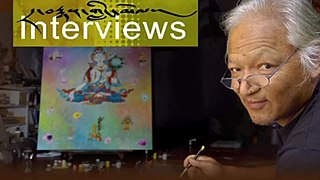 W
WKarma Phuntsok is a Tibetan painter.
 W
WThe Regong arts are the popular arts on the subject of Tibetan Buddhism. They are painting, sculpture, engraving, architecture, and embroidery. They are associated with communities in Tongren County and along the river Rongwo which crosses the current Huangnan Tibetan Autonomous Prefecture in the province of Qinghai in China.
 W
WSamsara is a 2001 independent film directed and co-written by Pan Nalin. An international co-production of India, Germany, France, Italy, and Switzerland, the film tells the story of a Buddhist monk's quest to find Enlightenment. It stars Shawn Ku as the monk Tashi, and Christy Chung as Pema.
 W
WSandpainting is the art of pouring coloured sands, and powdered pigments from minerals or crystals, or pigments from other natural or synthetic sources onto a surface to make a fixed or unfixed sand painting. Unfixed sand paintings have a long established cultural history in numerous social groupings around the globe, and are often temporary, ritual paintings prepared for religious or healing ceremonies. This form of art is also referred to as drypainting.
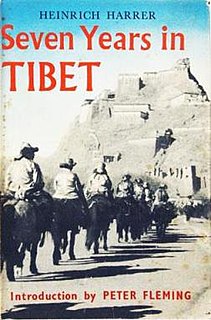 W
WSeven Years in Tibet: My Life Before, During and After is an autobiographical travel book written by Austrian mountaineer Heinrich Harrer based on his real life experiences in Tibet between 1944 and 1951 during the Second World War and the interim period before the Communist Chinese People's Liberation Army invaded Tibet in 1950.
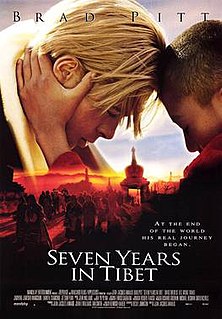 W
WSeven Years in Tibet is a 1997 American biographical war drama film based on the 1952 book of the same name. The book was written by Austrian mountaineer Heinrich Harrer on his experiences in Tibet between 1939 and 1951 during World War II, the interim period, and the Chinese People's Liberation Army's Battle of Chamdo in 1950. Seven Years in Tibet was directed by Jean-Jacques Annaud, stars Brad Pitt and David Thewlis, and has music composed by John Williams with a feature performance by renowned cellist Yo-Yo Ma.
 W
W"Shambala" is a song written by Daniel Moore and made famous by two near-simultaneous releases in 1973: the better-known but slightly later recording by Three Dog Night, which reached No. 3 on the Billboard Hot 100, and a version by B. W. Stevenson. Its title derives from a mythical place-name also spelled Shamballa or Shambhala.
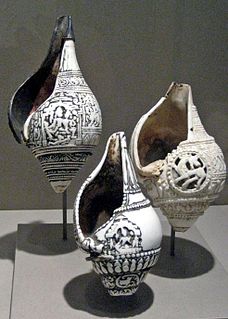 W
WA Shankha is a conch shell of ritual and religious importance in Hinduism. It is the shell of a large predatory sea snail, Turbinella pyrum, found in the Indian Ocean..
 W
WA thangka, variously spelt as thangka, tangka, thanka, or tanka, is a Tibetan Buddhist painting on cotton, silk appliqué, usually depicting a Buddhist deity, scene, or mandala. Thangkas are traditionally kept unframed and rolled up when not on display, mounted on a textile backing somewhat in the style of Chinese scroll paintings, with a further silk cover on the front. So treated, thangkas can last a long time, but because of their delicate nature, they have to be kept in dry places where moisture will not affect the quality of the silk. Most thangkas are relatively small, comparable in size to a Western half-length portrait, but some are extremely large, several metres in each dimension; these were designed to be displayed, typically for very brief periods on a monastery wall, as part of religious festivals. Most thangkas were intended for personal meditation or instruction of monastic students. They often have elaborate compositions including many very small figures. A central deity is often surrounded by other identified figures in a symmetrical composition. Narrative scenes are less common, but do appear.
 W
WFor more than a thousand years, Tibetan artists have played a key role in the cultural life of Tibet. From designs for painted furniture to elaborate murals in religious buildings, their efforts have permeated virtually every facet of life on the Tibetan plateau. The vast majority of surviving artworks created before the mid-20th century are dedicated to the depiction of religious subjects, with the main forms being thangka, distemper paintings on cloth, Tibetan Buddhist wall paintings, and small statues in bronze, or large ones in clay, stucco or wood. They were commissioned by religious establishments or by pious individuals for use within the practice of Tibetan Buddhism and were manufactured in large workshops by monks and lay artists, who are mostly unknown.
 W
WTibet developed a distinct culture due to its geographic and climatic conditions. While influenced by neighboring cultures from China, India, and Nepal, the Himalayan region's remoteness and inaccessibility have preserved distinct local influences, and stimulated the development of its distinct culture.
 W
WThe Tibetan horn is a long trumpet or horn used in Tibetan Buddhist and Mongolian buddhist ceremonies. It is the most widely used instrument in Tibetan Buddhist culture. It is often played in pairs or multiples, and the sound is compared to the singing of elephants. Tsultrim Allione described the sound: It is a long, deep, whirring, haunting wail that takes you out somewhere beyond the highest Himalaya peaks and at the same time back into your mother's womb.
 W
WTibetan incense is made in Tibet, Northern parts of Nepal, and Bhutan. Incense is an important representation of the Tibetan culture. These incenses have a characteristic "earthy" or herbal scent to them. Tibetan incenses can contain 30 or more ingredients. As with most Asian incense, Tibetan incense is not rolled around a bamboo stick, but is extruded into lengths or coils.
 W
WThe Tibetan Institute of Performing Arts (TIPA) was founded by Tenzin Gyatso, the 14th Dalai Lama on reaching McLeod Ganj, Himachal Pradesh, India in exile from Tibet in August 1959. It was then called Tibetan Music, Dance and Drama Society, which was one of the first institutes set up by the Dalai Lama, and was established to preserve Tibetan artistic heritage, especially opera, dance, and music.
 W
WThe Tree of physiology is a Tibetan Thangka depicting human physiology and certain pathological transformations.